
There were no strong convictions ahead of today’s jobs report – perhaps because everyone by now knows the numbers are all bogus and made up on the spot – and perhaps this time it was a good thing because while on one hand the payrolls print came in weaker than expected, driven by a sharp drop in private payrolls, the unemployment rate actually dropped below estimates, painting yet another mixed picture of what to expect.Here’s what the BLS reported in Trump’s first official jobs report since he returned to the White House: total payrolls printed at 143K… 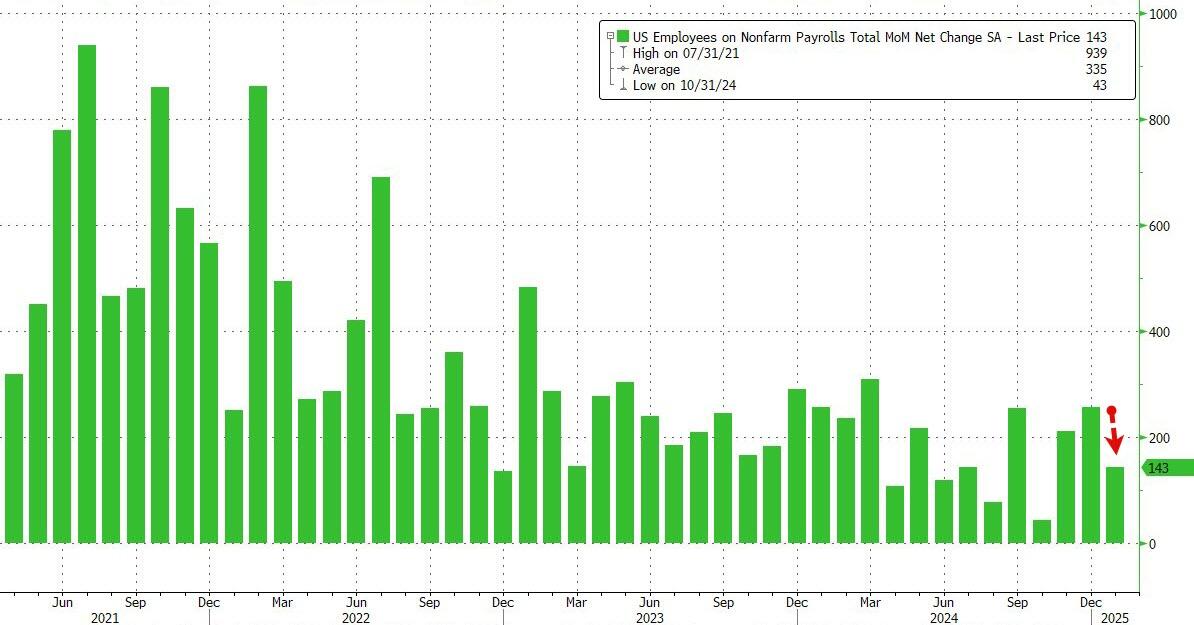 … down sharply from an upward revised 307K (256K originally) and missing estimates of 175K.
… down sharply from an upward revised 307K (256K originally) and missing estimates of 175K. 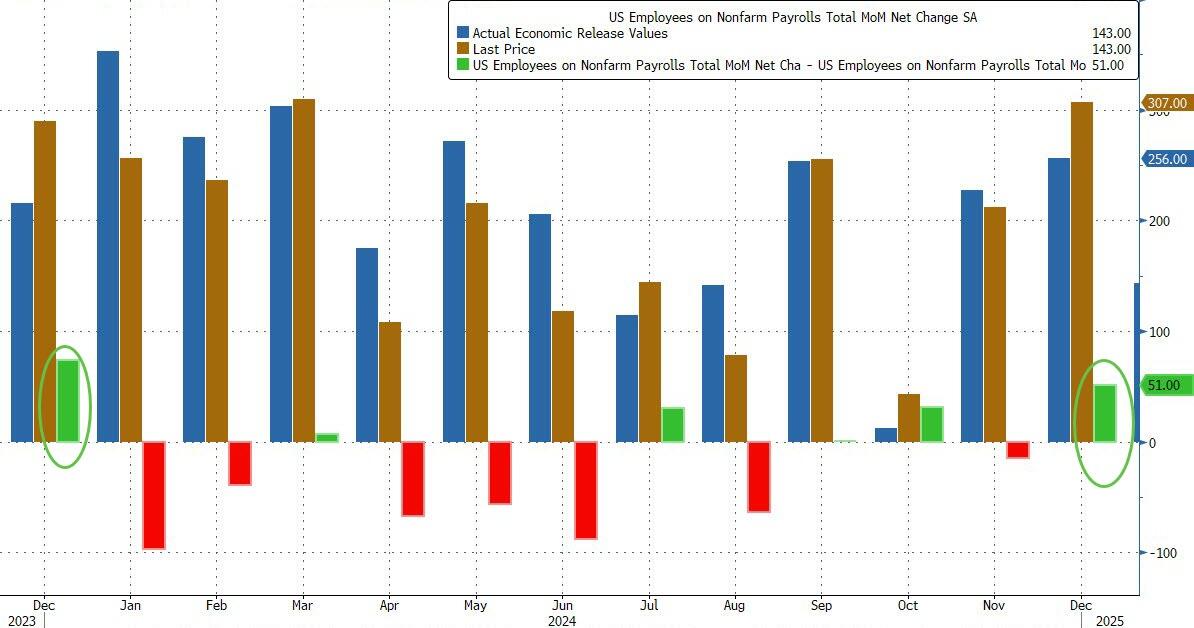 Looking further back, the change in total nonfarm payroll employment for November was revised up by 49,000, from +212,000 to +261,000, and when adding the +51,000 revision to December employment in November and December combined is 100,000 higher than previously reportedBut while the sequential change in the Establishment survey was notable, what was far more remarkable was the Household survey where we saw massive population related revisions (discussed last night), which pushed the civilian labor force higher by 2.2 million to 170.744 million, while the number of employed workers also increased by over 2.2 million to 163.895 million. As a result, the Household survey has finally caught up to Establishment survey…
Looking further back, the change in total nonfarm payroll employment for November was revised up by 49,000, from +212,000 to +261,000, and when adding the +51,000 revision to December employment in November and December combined is 100,000 higher than previously reportedBut while the sequential change in the Establishment survey was notable, what was far more remarkable was the Household survey where we saw massive population related revisions (discussed last night), which pushed the civilian labor force higher by 2.2 million to 170.744 million, while the number of employed workers also increased by over 2.2 million to 163.895 million. As a result, the Household survey has finally caught up to Establishment survey… 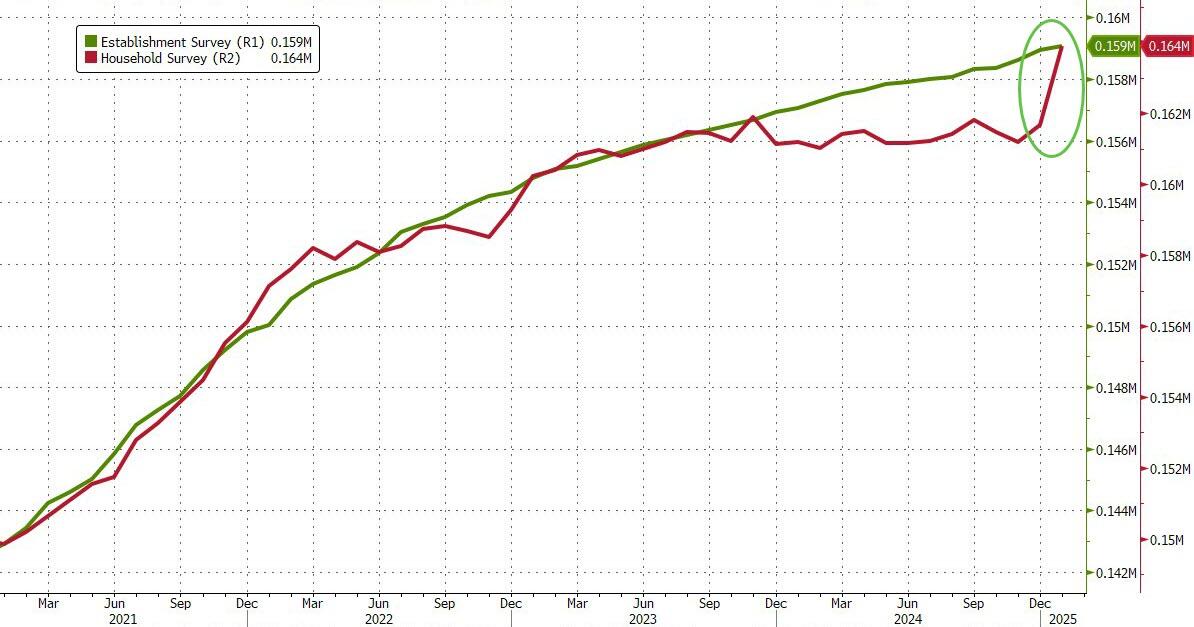 … and since the number of Unemployed people actually declined (to 6.849 million from 6.886 million) while the number of employed workers rose by 2.2 million to 163.9 million, the unemployment rate declined to 4.0% from 4.1%, and the lowest since May of 2024!
… and since the number of Unemployed people actually declined (to 6.849 million from 6.886 million) while the number of employed workers rose by 2.2 million to 163.9 million, the unemployment rate declined to 4.0% from 4.1%, and the lowest since May of 2024! 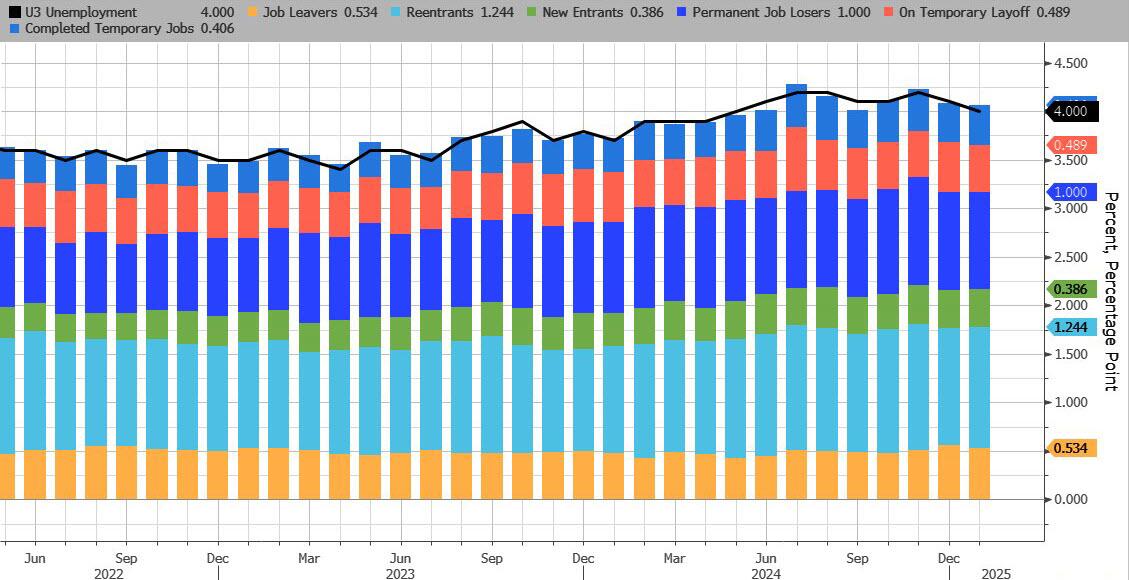 According to the BLS, the unemployment rates for adult men (3.7 percent), adult women (3.7 percent), teenagers (11.8 percent), Whites (3.5 percent), Blacks (6.2 percent), Asians (3.7 percent), and Hispanics (4.8 percent) “showed little or no change in January”, although as can be seen on the chart above, white unemployment is dropping notably while black unemployment rate is rising.
According to the BLS, the unemployment rates for adult men (3.7 percent), adult women (3.7 percent), teenagers (11.8 percent), Whites (3.5 percent), Blacks (6.2 percent), Asians (3.7 percent), and Hispanics (4.8 percent) “showed little or no change in January”, although as can be seen on the chart above, white unemployment is dropping notably while black unemployment rate is rising. 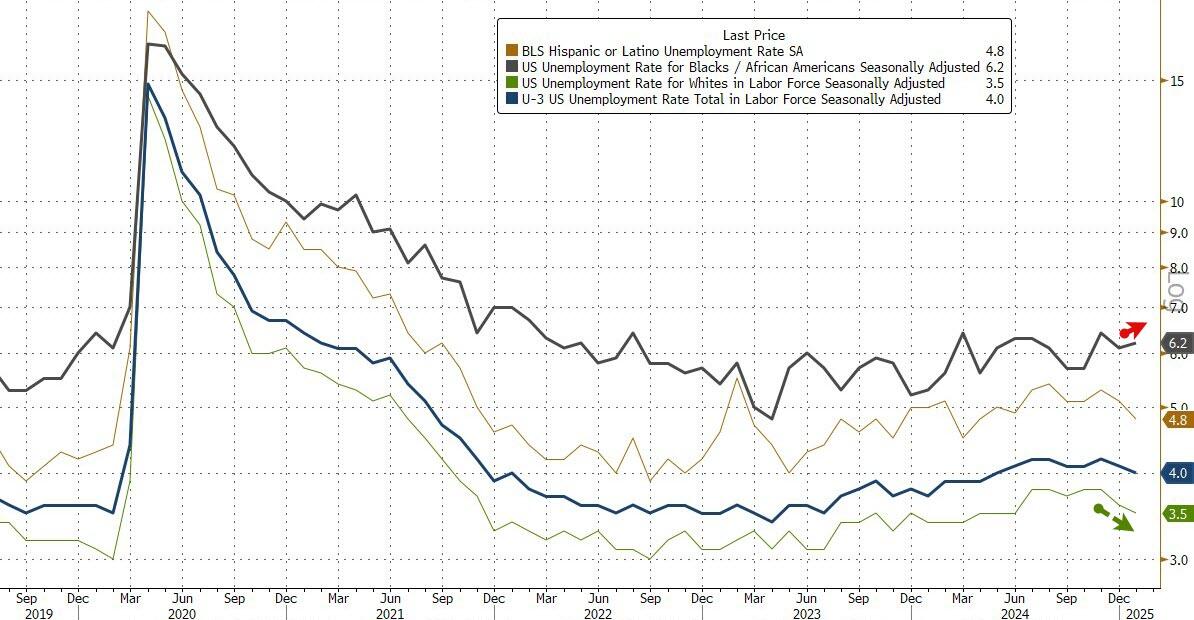 Despite the drop in the unemployment rate, the participation rate actually rose modestly from 62.5% to 62.6%.
Despite the drop in the unemployment rate, the participation rate actually rose modestly from 62.5% to 62.6%. 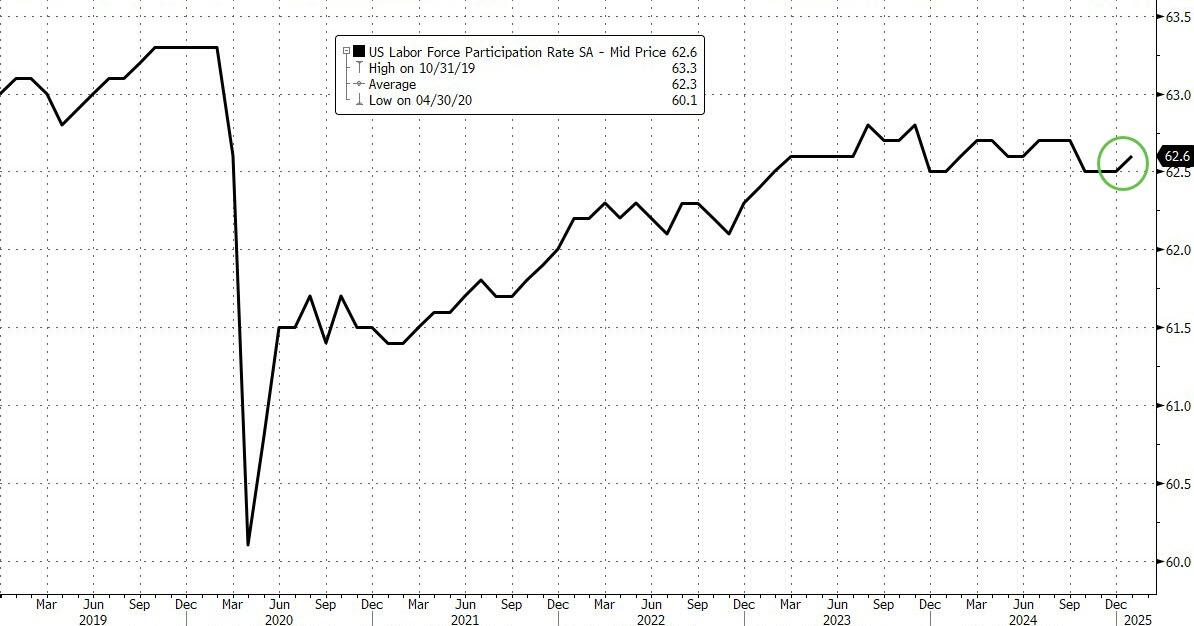 Some more qualitative details from the report:
Some more qualitative details from the report:
All of this, of course, is in the context of the massive downward revisions to 2024 payrolls which we discussed last night, and which look as follows: roughly 600K jobs lost every month last year. 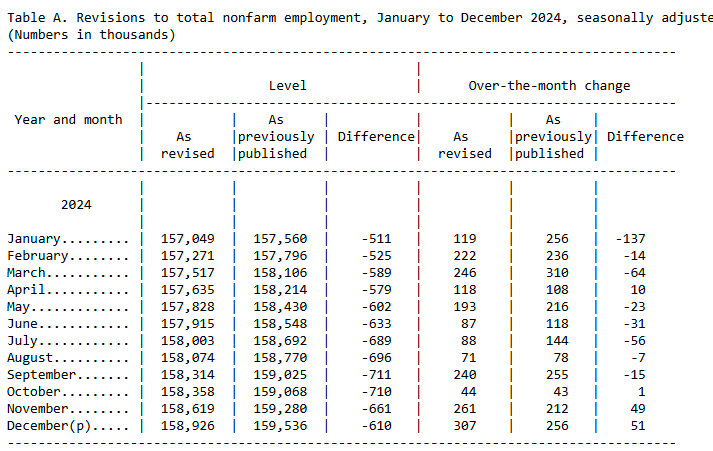 Taking a closer look at the annual revisions which we discussed last night, and which affected both the Establishment Survey data and the Household Survey, this is what the BLS said, starting with the Establishment Survey:
Taking a closer look at the annual revisions which we discussed last night, and which affected both the Establishment Survey data and the Household Survey, this is what the BLS said, starting with the Establishment Survey:
In accordance with annual practice, the establishment survey data released today have been benchmarked to reflect comprehensive counts of payroll jobs for March 2024. These counts are derived principally from the Quarterly Census of Employment and Wages (QCEW), which counts jobs covered by the Unemployment Insurance (UI) tax system. The benchmark process results in revisions to not seasonally adjusted data from April 2023 forward. Seasonally adjusted data from January 2020 forward are subject to revision. In addition, data for some series prior to 2020, both seasonally adjusted and unadjusted, incorporate other revisions.
The seasonally adjusted total nonfarm employment level for March 2024 was revised downward by 589,000. On a not seasonally adjusted basis, the total nonfarm employment level for March 2024 was revised downward by 598,000, or -0.4 percent. Not seasonally adjusted, the absolute average benchmark revision over the past 10 years is 0.1 percent.
The over-the-year change in total nonfarm employment for March 2024 was revised from +2,900,000 to +2,346,000 (seasonally adjusted). Table A presents revised total nonfarm employment data on a seasonally adjusted basis from January to December 2024.
And here is the Household:
Effective with data for January 2025, updated population estimates were incorporated into the household survey. Population estimates for the household survey are developed by the U.S. Census Bureau. Each year, the Census Bureau updates their population estimates to incorporate new information and assumptions about the growth of the population since the most recent population base year, typically the last decennial census. The change in population reflected in the new estimates results from adjustments for net international migration, updated vital statistics on births and deaths, and improvements in estimation methodology.
This year’s adjustment was large relative to adjustments in past years. It reflects both updated methodology and new information about net international migration in recent years.
In accordance with usual practice, BLS did not revise the official household survey estimates for December 2024 and earlier months. However, to show the impact of the population adjustments, table B displays differences in selected December 2024 labor force series based on the old and new population estimates.
Table B shows the adjustment increased the estimated size of the civilian noninstitutional population age 16 and over in December by 2.9 million. The increases in population were relatively large for Asians and Hispanics. The adjustment increased the total civilian labor force by 2.1 million, including increases of 2.0 million in employment and 105,000 in unemployment. The number of people not in the labor force increased by 765,000. Although the effect on levels was relatively large, the effect on rates and ratios was small. The adjustment increased the total unemployment rate, employment-population ratio, and labor force participation rate by 0.1 percentage point each. The effects of the adjustment on these ratesfor the major worker groups were also relatively small.
While we will do a thorough breakdown of these numbers, perhaps the biggest surprise was in the wage department, because according to the BLS, average hourly earnings printed at 4.1% YoY, beating soundly the 3.8% estimates and unchanged from an upward revised December print (which was 3.9% before). 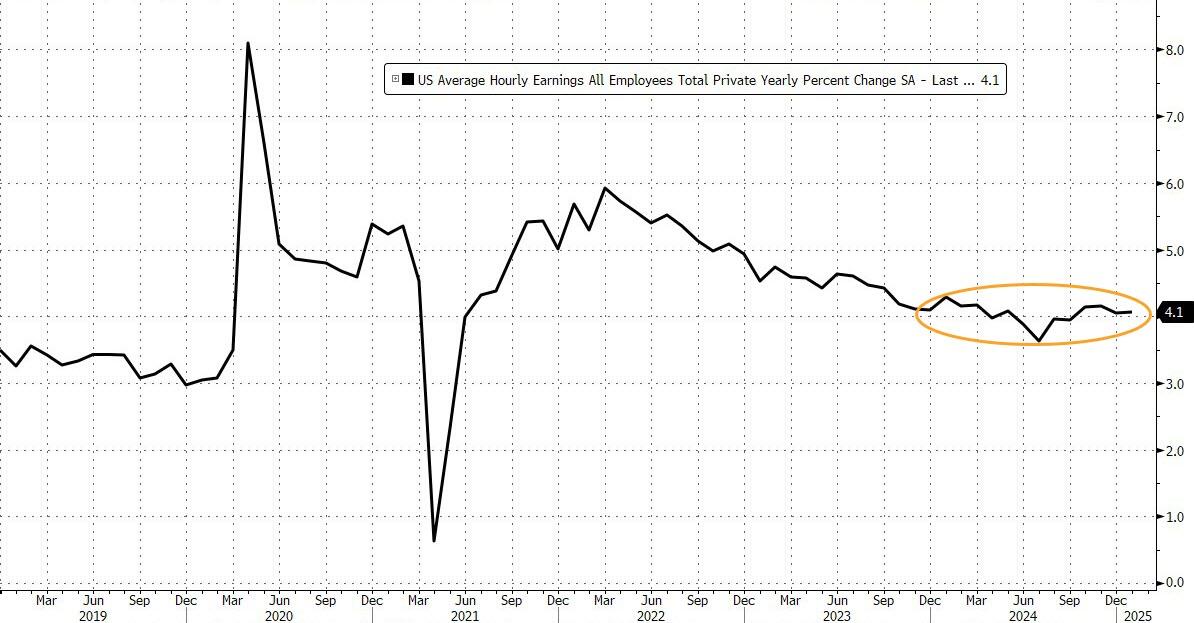 While some had worried that the recent California fires could impact today’s survey, the BLS denied that with the following comment:
While some had worried that the recent California fires could impact today’s survey, the BLS denied that with the following comment:
Wildfires in Southern California began in early January and continued through the reference periods for both the household and establishment surveys. Severe winter weather occurred in much of the country during the January reference periods for both surveys. These events had no discernible effect on national payroll employment, hours, and earnings from the establishment survey, nor on the national unemployment rate from the household survey. Response rates for the two surveys were within normal ranges.
Finally, taking a closer look at the Establishment Survey we find the following breakdown of jobs by industry:
And visually 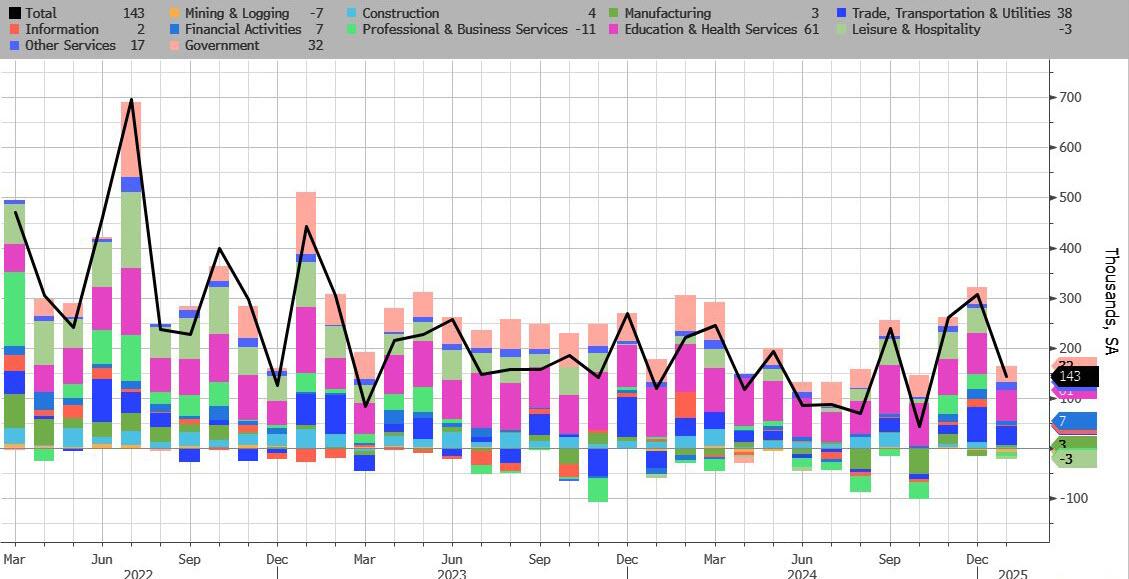 More By This Author:Amazon Reverses 7% After Hours Plunge Despite Cloud Miss, Ugly Guidance
More By This Author:Amazon Reverses 7% After Hours Plunge Despite Cloud Miss, Ugly Guidance
At Least 40,000 Fed Workers Accept ‘DOGE Buyout’ As Deadline Looms Tonight
US Services Sector Surveys Plunged In January As Prices Rose & Orders Fell
















